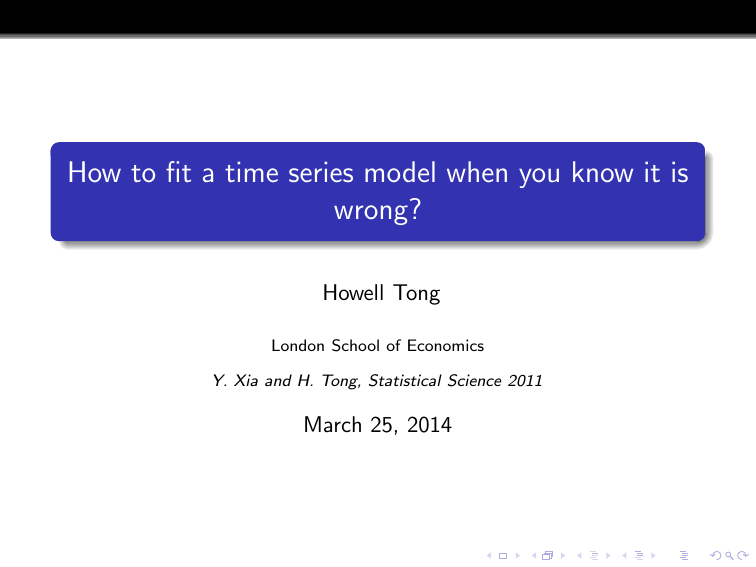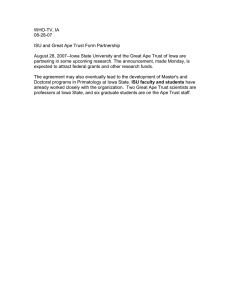How to fit a time series model when you know... wrong? Howell Tong March 25, 2014
advertisement

How to fit a time series model when you know it is
wrong?
Howell Tong
London School of Economics
Y. Xia and H. Tong, Statistical Science 2011
March 25, 2014
Introduction
A New Approach
Outline
1
Introduction
2
A New Approach
3
Real Data
4
Conclusions
Real Data
Conclusions
Introduction
A New Approach
Real Data
Conclusions
Are Conventional Methods of Estimation Fit for Purpose?
Conventional Methods of Parametric Modelling
1
Assume that there is a true model;
2
Evaluate the efficacy of the estimation as if the postulated
model is true.
Introduction
A New Approach
Real Data
Conclusions
Are Conventional Methods of Estimation Fit for Purpose?
Let
y = the observed/real data
x = the data generated by the postulated model.
Introduction
A New Approach
Real Data
Conclusions
Are Conventional Methods of Estimation Fit for Purpose?
Postulated Model
xt = gθ (xt−1 , ..., xt−p ) + εt ,
(1)
where εt is the innovation, and the function gθ (.) is known up to
parameters θ.
Introduction
A New Approach
Real Data
Conclusions
Are Conventional Methods of Estimation Fit for Purpose?
Observed Data: {y1 , y2 , · · · , yT }
Conventional methods
Typically minimize a loss function
−1
L(θ) = (T − p)
T
−1
X
{yt+1 − gθ (yt , ..., yt−p+1 )}2 ,
t=p
where, here and elsewhere, T denotes the sample size.
Introduction
A New Approach
Real Data
Conclusions
Are Conventional Methods of Estimation Fit for Purpose?
Efficient IF the postulated model
xt = gθ (xt−1 , ..., xt−p ) + εt ,
is true.
Introduction
A New Approach
Real Data
Conclusions
Are Conventional Methods of Estimation Fit for Purpose?
Match observations {y1 , y2 , ..., yT }, by postulating g.
Postulate linear gθ , Gaussian εt , zero mean, finite var(εt ).
Let
{C(j), j = 0, 1, 2, ..., T − 1}
denote the sample autocovariance function of the y-data.
Minimizing L(θ) yields well-known estimates of θ that are functions
of
S = {C(0), C(1), ..., C(p)}.
Introduction
A New Approach
Real Data
Conclusions
Are Conventional Methods of Estimation Fit for Purpose?
1
Postulated model is right
S is a minimal set of sufficient statistics (ignoring boundary
effects)
2
Postulated model is wrong
It is unlikely that S is a minimal set of sufficient statistics.
Introduction
A New Approach
Real Data
Multi-step predictions
ARIMA(0,1,1) model leads to EWMA predictor:
(1 − B)Xt = (1 − ηB)et
X̂t (1) = (1 − η)Xt + η X̂t−1 (1).
X̂t (ℓ) = X̂t (ℓ − 1); ℓ = 2, 3, . . .
Conclusions
Introduction
A New Approach
Real Data
Figure: Box and Jenkins Series A-Chemical Process Concentration
Readings: every two hours
Conclusions
Introduction
A New Approach
Real Data
Conclusions
Figure: Ave(η(ℓ)) refers to model in pocket ℓ. R̂(ℓ) is ratio of ave
squared prediction errors using η estimated in 1st pocket to that in the
Introduction
A New Approach
Real Data
George Box
1
Essentially, all models are wrong, but some are useful.
2
Consistency of estimation is predicated on the model being
correct/true.
3
Post-modelling reconciliation of Box’s dictum : diagnostic
checks, goodness of fit tests, etc.
Challenge
Recognising Box’s dictum right at the modelling stage.
Conclusions
Introduction
A New Approach
Real Data
Conclusions
Catch-all Approach
Our objective
Good matching of salient features of the observed time series.
Short-term prediction is secondary.
Introduction
A New Approach
Real Data
Conclusions
Catch-all Approach
For expositional simplicity, let p = 1.
We want
P {x1 (θ0 ) < u1 , ..., xn (θ0 ) < un |x0 (θ0 ) = y0 }
to be as close as possible to
≡ P {y1 < u1 , ..., yn < un |y0 }
almost surely for some θ0 and any n and real values u1 , u2 , . . . , un .
Introduction
A New Approach
Real Data
First Weaker Form
First weaker form
Generalize the loss function to
L(θ) = (T − p)−1
Q
T
−1 X
X
[m]
wm {yt+m − gθ (yt , ..., yt−p+1 ), }2 ,
t=p m=1
where
[m]
gθ (yt , ..., yt−p+1 ) = E(xt+m |xt = yt , . . . , xt−p+1 = yt−p+1 ),
P
and wm ≥ 0 and
wm = 1.
Conclusions
Introduction
A New Approach
Real Data
Conclusions
Second Weaker Form
Suppose that observable{yt } and generated {xt (θ)} are both
second-order stationary.
DC (yt , xt (θ)) = sup
∞
X
wm {γx(θ) (m) − γy (m)}2 .
{wm } m=0
∞
1
1X
fy (ω) =
γ(0) +
γy (k) cos(kω).
2π
π
k=1
DF (yt , xt (θ)) =
Z
π
n f (ω)
o
f (ω)
y
+ log( x
) − 1 dω.
fy (ω)
−π fx (ω)
Introduction
A New Approach
Real Data
Second Weaker Form
Whittle’s likelihood
T n
o
X
I(ωj )
θ̂ = min
+ log(fθ (ωj )) ,
θ
fθ (ωj )
j=1
where
I(ω) =
T
2
1 X
yt exp(−ιωt)
2πT
t=1
and ωj = 2πj/T .
Whittle’s likelihood matches the second-order moments by
using a natural sample version of DF (yt , xt (θ)) up to a
constant.
Conclusions
Introduction
A New Approach
Real Data
Conclusions
Example R1 [Sea levels]
15
sea levels
10
5
0
−5
−10
−15
1994
1996
1998
2000
2002
year
2004
2006
2008
Introduction
A New Approach
Real Data
Conclusions
Example R1 [Sea levels]
Postulated model= AR(6), using AIC for order determination.
SDF
MLE; Whittle; APE(≤ 20)
2
2
2
1
1
1
0
0
2
0
0
2
0
0
2
Introduction
A New Approach
Real Data
Conclusions
Example R1 [Sea levels]
relative averaged multi-step ahead prediction errors by taking those of the one-step method as 1 unit.
o = APE(≤ 10); × =APE(≤ 20); ⋆ = APE(≤ 30); ⋄ = APE(≤ 50)
relative prediction errors
1.05
1
0.95
5
10
15
20
no. of steps ahead
25
30
Introduction
A New Approach
Real Data
Conclusions
Example R2: Nicholson’s Blowflies
Total number of blowflies (Lucilia cuprina) under controlled
laboratory conditions.
Counts for every second day.
The developmental delay (from egg to adult) is between 14-15
days.
Nicholson obtained 361 bi-daily recordings over a 2-year
period (722 days).
A major transition appears to have occurred around day 400.
Following Tong (1990), we consider the first part of the time
series (to day 400, thus T=200), for which the population has
a 19-bi-day cycle; see figure.
Introduction
A New Approach
Real Data
Conclusions
We postulate the single species animal population discrete model
as suggested by Gurney et al. (1980), and thus
xt = P oisson(cxt−τ exp(−xt−τ /N0 )xt−τ + νxt−1 ),
where we take τ = 8 (bi-days) corresponding to the time taken for
an egg to develop into an adult.
3 parameters: c, N0 and ν.
MLE estimates for the parameters are
ĉ = 8.49, N̂0 = 528.23, ν̂ = 0.77.
Catch-all method gives
ĉ = 8.82, N̂0 = 604.98, ν̂ = 0.67.
Introduction
A New Approach
Real Data
Conclusions
10
10
x 10
x 10
2.5
3
power
2
2
1.5
1
1
0.5
0
0
10
20
30
40
period (bi−days/cycle)
50
0
0
10
20
30
40
period (bi−days/cycle)
50
A New Approach
population
population
Introduction
Real Data
Conclusions
10000
5000
0
0
50
100
150
0
50
100
150
200
250
300
350
400
200
250
300
350
400
10000
5000
0
Time(days)
Introduction
A New Approach
Real Data
Conclusions
How do the cycles change with the time needed by the fly
to grow to maturity?
We vary the time τ from 4 to 100 bi-days. The corresponding
cycles (in bi-days) are shown in the figure.
APE(≤ T ) shows a clear linearly increasing trend in the
cycle-periods as τ increases.
APE(≤ 1) shows strange excursions that are difficult to
interpret.
Introduction
A New Approach
Real Data
Conclusions
Example R3: [Measles in London]
Postulated SIR model for the transmission of measles [infected (I);
susceptible (S); birth (B)]:
It+1 = exp(δt,k βk )St It , St+1 = St +Bt −It+1 = S0 +
t
X
Bτ −
τ =0
t+1
X
τ =1
It cannot be observed; can observe yt that has mean It . For
observable yt , we postulate model
xt = P oi(It ),
where (δt,k βk ) is employed to indicate the seasonality force, with
δt,k = 1 if time t is at the kth season, 0 otherwise.
For measles, the time unit for t is bi-weekly, based on the
infection procedure of measle.
Iτ ,
Introduction
A New Approach
Real Data
Conclusions
Table: Estimated parameters in the transmission model
method
APE(≤ 1)
APE(≤ T )
APE(≤ 1)
APE(≤ T )
APE(≤ 1)
APE(≤ T )
APE(≤ 1)
APE(≤ T )
β1
-11.92
-11.95
β9
-11.92
-11.95
β17
-11.95
-11.97
β25
-11.99
-11.99
β2
-12.00
-12.00
β10
-11.99
-11.99
β18
-12.15
-12.08
β26
-11.98
-11.98
β3
-11.88
-11.93
β11
-12.05
-12.03
β19
-12.28
-12.16
S0
178280
168190
β4
-11.99
-11.99
β12
-12.01
-12.00
β20
-12.40
-12.23
β5
-11.89
-11.93
β13
-11.93
-11.96
β21
-12.21
-12.12
β6
-11.81
-11.89
β14
-11.96
-11.98
β22
-11.99
-11.99
β7
-11.89
-11.93
β15
-11.98
-11.99
β23
-11.79
-11.87
β8
-11.97
-11.98
β16
-12.04
-12.02
β24
-11.87
-11.92
Introduction
A New Approach
Real Data
Conclusions
measles cases in London
The skeletons based on APE(≤ 1) and APE(≤ T ) are shown in
solid red line in panel 1 and panel 2. APE(≤ T ) much better
match than APE(≤ 1) in terms of outbreak scale and cycle period.
10000
5000
0
1970
1975
1980
1985
1990
1970
1975
1980
1985
1990
1970
1975
1980
1985
1990
6000
4000
2000
adjusted biweekly
births
0
3000
2000
1000
0
Introduction
A New Approach
Real Data
Conclusions
The periodogram is also much better matched by APE(≤ T ) than
by APE(≤ 1).
10
power
15
10
x 10
6
10
4
5
2
0
0
50
100
150
period (biweeks/cycle)
0
x 10
0
50
100
150
period (biweeks/cycle)
Introduction
A New Approach
Real Data
Conclusions
period (years/cycle)
6
5
4
3
2
1
0
0
2000
4000
6000
8000
10000
number of births
Figure shows clearly that when the birth rate is high (from about 5000 and
above) the cycle is annual, but when the birth rate is medium at about 3000 to
4000, the cycles become two-year cycles.
Introduction
A New Approach
Real Data
Conclusions
As the birth rate gets lower, the model shows that cycle become
three-year cycles or even five-year cycles. Thus, the postulated
model has thrown some light on the effect of the birth rate on the
frequency of outbreaks of measles.
Our conclusion agrees with the changing cycle-periods observer
over different time durations and at different places as reported by
the epidemiologists Earn et al. Nature, 2000.
Introduction
A New Approach
Real Data
Conclusions
Conclusions
(1) Truer to Box than Box!
(2) Ways to improve the ability of a postulated parametric model
to match features (e.g. second-order moments, cycles, and
others) of the observed time series that are deemed important;
Introduction
A New Approach
Real Data
Conclusions
Conclusions
(3) Methods based on just the one-step-ahead prediction often
found unfit for purpose, in many situations:
the absence of a true model
short data sets
observation errors
highly cyclical data
and others
(4) Deeper understanding of Whittle’s likelihood as an extended
likelihood of a model; W-likelihood is a precursor of
XT-likelihood.
Introduction
A New Approach
Real Data
TONY, ENJOY YOUR PERMANENT SABBATICAL
LEAVE!
Conclusions
Introduction
A New Approach
Real Data
Conclusions
Optimal Parameter
For some positive integer m (which may be infinite), we define the
optimal parameter by
ϑm,w = arg min
θ
m
X
k=1
2
wk E yt+k − E{xt+k (θ)|Xt (θ) = Yt } ,
where Xt (θ) = (xt (θ), xt−1 (θ), . . . , xt+p−1 (θ)), and {wk } define
the weight function, typically positive and summing to unity.
Introduction
A New Approach
Real Data
Conclusions
Optimal Parameter
For ease of exposition, we assume that the solution to the above
minimization is unique. Then we have immediately
Theorem
Under general conditions
θ̃{m} → ϑm,w
in probability as the sample size T → ∞.




